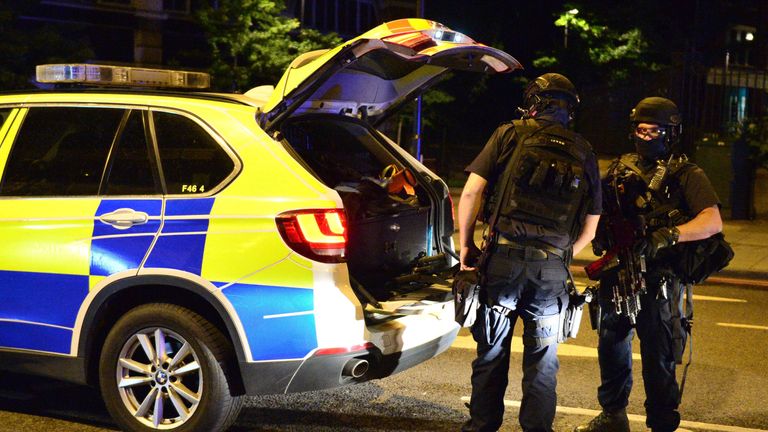Was it a mistake to lower the UK terror threat before London Bridge attack?
Sky's Defence Correspondent explains how the threat level is assessed and why it may have been lowered before the latest outrage.
Monday 5 June 2017 08:14, UK
It won't go unnoticed that the attacks in London occurred less than a week after the national threat level was lowered following the Manchester bomb.
I'll try and explain why, and if it was right to do so.
There are effectively four threat levels in the UK which cover: The threat from international terrorism, the threat from Northern Ireland-related terrorism in Northern Ireland and then the same but for Great Britain.
Those three are made public. A fourth level, or rather a set of levels, remain secret. They are specific to parts of national infrastructure such as power stations or the rail network.
In October 2016, the threat level for the London Underground was briefly raised to Severe when a suspect device was found on a tube train near the O2 arena in Greenwich.
News of this leaked from an email accidentally sent around the Ministry of Defence.
The threat level from international terrorism is set by JTAC - the Joint Terrorism Analysis Centre.
It sits within MI5 and is deliberately independent of government. JTAC constantly reviews the threat level, daily.
Their decision to raise or lower it is based on objective analysis of current intelligence, not as a result of the political desires or motivations of the government of the day.
The main UK threat level has been at either Severe (meaning an attack is "highly likely") or Critical (an attack is "imminent") since 29 August 2014.
There is nothing we know, at this stage, to link the attacks in Manchester and London.
The perpetrators clearly shared a desire to kill and injure innocent and random people. In time we might also learn they shared a similar ideology.
But the attacks, if similar in motive, were very different in method - one a suicide bomber, the other three men armed with knives and fake explosive vests.
From what we know at this early stage, we must view the attacks as separate.
The threat level was raised after the bomb in Manchester because the security services faced too many unknowns.
The ability to build and detonate a bomb requires a level of knowledge and equipment that is almost impossible for one man to accomplish alone.
It was inevitable that Salman Abedi had help and so there was an immediate rush to hunt down his network. The prospect of a secondary attack was real.
It was in this context that JTAC raised the level and only for as long as was absolutely necessary.
It didn't even stay at Critical through the busy bank holiday weekend for safety's sake.
Once that network had been rounded up, at least to a satisfactory extent, the threat level was lowered.
Note that it was lowered only to Severe, the fourth highest level - JTAC was in no way discounting the threat of further attacks, it just assessed that one was not imminent.
It would come as no surprise if we learn that the London attackers took inspiration or motivation from the Manchester killings.
Their target wasn't young girls and boys at a pop concert but it was still people enjoying a night out - there is a similarity there.
Intelligence assessments are always best judgements based on available information - they are rarely exact.
There is much we have yet to learn about both the London and Manchester attacks.
By the very fact that they happened, mistakes must have been made, but in my opinion, lowering the threat level wasn't one of them.
It might be that again the threat level is raised to Critical, and this time it might stay there.






